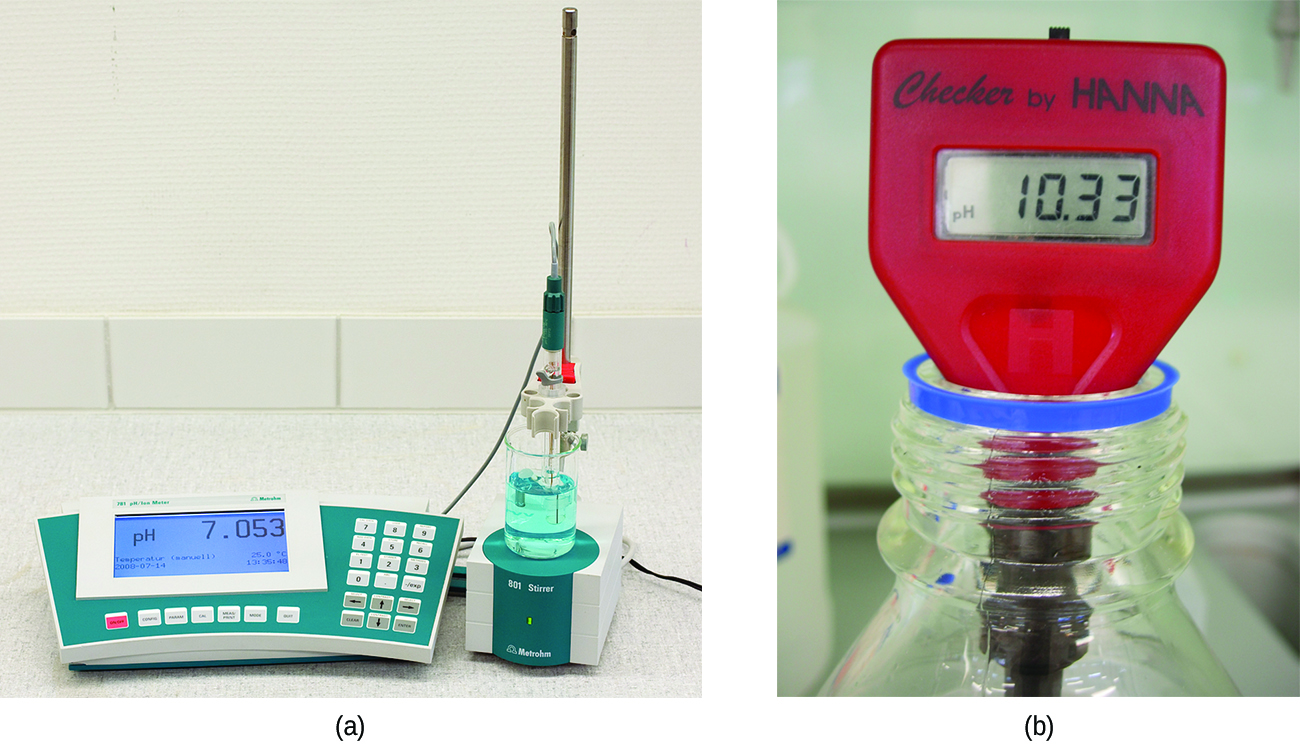| << Chapter < Page | Chapter >> Page > |
The pH can be found from the pOH:
pOH = 11.6, pH = 2.4
The acidity of a solution is typically assessed experimentally by measurement of its pH. The pOH of a solution is not usually measured, as it is easily calculated from an experimentally determined pH value. The pH of a solution can be directly measured using a pH meter ( [link] ).

The pH of a solution may also be visually estimated using colored indicators ( [link] ).

The concentration of hydronium ion in a solution of an acid in water is greater than 1.0 10 −7 M at 25 °C. The concentration of hydroxide ion in a solution of a base in water is greater than 1.0 10 −7 M at 25 °C. The concentration of in a solution can be expressed as the pH of the solution; pH = −log The concentration of OH − can be expressed as the pOH of the solution: pOH = −log[OH − ]. In pure water, pH = 7.00 and pOH = 7.00
Explain why a sample of pure water at 40 °C is neutral even though [H 3 O + ] = 1.7 10 −7 M . K w is 2.9 10 −14 at 40 °C.
In a neutral solution [H
3 O
+ ] = [OH
− ]. At 40 °C,
[H
3 O
+ ] = [OH
− ] = (2.910
−14 )
1/2 = 1.7
10
−7 .
The ionization constant for water ( K w ) is 2.9 10 −14 at 40 °C. Calculate [H 3 O + ], [OH − ], pH, and pOH for pure water at 40 °C.
The ionization constant for water ( K w ) is 9.311 10 −14 at 60 °C. Calculate [H 3 O + ], [OH − ], pH, and pOH for pure water at 60 °C.
x = 3.051
10
−7
M = [H
3 O
+ ] = [OH
− ]
pH = −log3.051
10
−7 = −(−6.5156) = 6.5156
pOH = pH = 6.5156
Calculate the pH and the pOH of each of the following solutions at 25 °C for which the substances ionize completely:
(a) 0.200 M HCl
(b) 0.0143 M NaOH
(c) 3.0 M HNO 3
(d) 0.0031 M Ca(OH) 2
Calculate the pH and the pOH of each of the following solutions at 25 °C for which the substances ionize completely:
(a) 0.000259 M HClO 4
(b) 0.21 M NaOH
(c) 0.000071 M Ba(OH) 2
(d) 2.5 M KOH
(a) pH = 3.587; pOH = 10.413; (b) pH = 0.68; pOH = 13.32; (c) pOH = 3.85; pH = 10.15; (d) pH = −0.40; pOH = 14.4
What are the pH and pOH of a solution of 2.0 M HCl, which ionizes completely?
What are the hydronium and hydroxide ion concentrations in a solution whose pH is 6.52?
[H 3 O + ] = 3.0 10 −7 M ; [OH − ] = 3.3 10 −8 M
Calculate the hydrogen ion concentration and the hydroxide ion concentration in wine from its pH. See [link] for useful information.
Calculate the hydronium ion concentration and the hydroxide ion concentration in lime juice from its pH. See [link] for useful information.
[H 3 O + ] = 1 10 −2 M ; [OH − ] = 1 10 −12 M
The hydronium ion concentration in a sample of rainwater is found to be 1.7 10 −6 M at 25 °C. What is the concentration of hydroxide ions in the rainwater?
The hydroxide ion concentration in household ammonia is 3.2 10 −3 M at 25 °C. What is the concentration of hydronium ions in the solution?
[OH − ] = 3.1 10 −12 M

Notification Switch
Would you like to follow the 'Chemistry' conversation and receive update notifications?